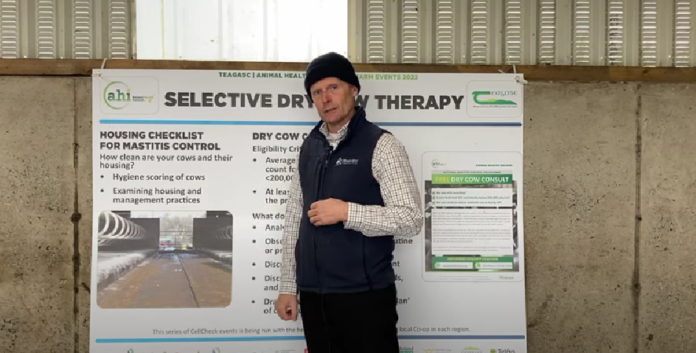“Dry cow housing is the biggest challenge for farmers over the next two or three years.”
That is according to Willie Buckley, vet at Riverview Veterinary in Bandon, Cork, and member of the technical working group of Animal Health Ireland (AHI).
He made the remark in a recent video with Teagasc, during which, he discussed selective dry cow therapy (SDCT) and free dry cow consultations that Irish dairy farmers can now avail of as part of the National Mastitis Control Programme under the Targeted Advisory Service on Animal Health.
The service aims to develop farm-specific selective dry cow strategies where appropriate.
As part of the service, a vet conducts a 3-hour free consultation, where he/she visits farm and reviews ICFB and farm records, the farm’s drying off procedure and dry cow management and then draws up an agreed treatment plan of cows suitable for SDCT.
To quality, you must:
- Average bulk milk tank SCC for the last 12 months is < 200,000 cells/mL;
- At least 4 whole herd milk recordings in the last 12 months;
- Ready to reduce antibiotic use at drying off;
- Milk recordings – at least 4 milk recordings in the previous 12 months.
SDCT
In a video produced by Teagasc, the vet commented: “The idea of this is that we are going to select the cows that are most suitable for teat sealer only.”
“Obviously, on the other side of that, you are going to select the cows that are going to get antibiotics because they have evidence of infection during the previous lactation. That will be shown by clinical mastitis records, milk recording records or cultures and sensitivities.”
“When your vet comes out, they will have gone through a lot of your milk recording data and will need to collate all other information that you have.”
“Then, they will observe the drying-off process, which involves them watching you drying off two or three cows. You work together, and if there is anything that needs to be clarified or perfected, they will discuss that with you.”’
“The drying off process now is a surgical procedure. You have to be so clean when doing it; you have to do it right and cannot do too many cows at a time.”
“I think farmers, once they know how to dry off a cow properly, and they have seen it done, I think this will be a process that farmers will easily perfect over one or two years.”
“With the whole process of what is happening now is that we [vets] can only prescribe for cows that are infected. You are only going to get antibiotic dry cow tubes for about 20-30-40% of your cows on the farm at drying off.”
Dry cow housing
The vet stated that this is going to lead you to the vast majority of cows with no antibiotics inside in their udders in the dry cow period, which means if you do the drying off process surgically and as clean as possible, the next risk to your cow is during dry cow housing.
This vet’s tips:
- Ask yourself: How clean are your cows and their housing?
- Hygiene scoring cows and examining housing and management practices;
- Have adequate dry cow housing – 110 cubicles for 100 cows;
- Clean main passageways as often as possible;
- Minor passageways need to be cleaned at least twice a day;
- Lime cubicles;
- Cubicles have to be dry;
- Ventilation has to be correct;
- If you have a loose box or hay, have adequate space with dry bedding.
The vet continued: “I believe farmers will conquer the challenge of drying off cows properly and not putting in any bugs during sealing.”
“In the past, cows were sealed and had blanket antibiotic dry cow tubes, which made up for a lot of deficiencies in housing.”
“But now, [dry cow housing] is going to be the focus. You have a clean, sealed off cow that has no infection and you have to keep her without infection. This is the critical area where people are going to work on,” he concluded.
Other news on That’s Farming:
In a previous article, Sinead Quealy, managing director of Virtual Vet, discussed new EU vet medicine laws, which you can read.
Note: This is an information article. Always consult your vet for advice.





